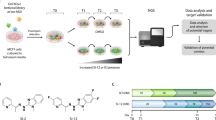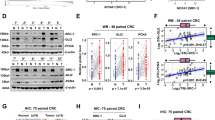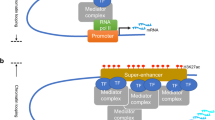Abstract
Steroid receptor coactivator-3 (SRC-3, also known as NCoA3, AIB1, p/CIP, RAC3, ACTR, and TRAM1), localized on a frequently amplified region, 20q12, has been associated with multiple cancers, including breast, gastric and prostate cancers. Although SRC-3 has been implicated as an oncogene, compelling evidence has only recently emerged implicating it as a causal factor in the genesis of human cancers. Here, we summarize recent evidence that indicates aberrant SRC-3 expression is important in hormone-sensitive and -insensitive human cancers.
Similar content being viewed by others
Log in or create a free account to read this content
Gain free access to this article, as well as selected content from this journal and more on nature.com
or
References
Anzick SL, Kononen J, Walker RL, Azorsa DO, Tanner MM, Guan XY, et al. AIB1, a novel estrogen receptor co-activator amplified in breast and ovarian cancer. Science 1997; 277: 965–8.
Torchia J, Rose DW, Inostroza J, Kamei Y, Westin S, Glass CK, et al. The transcriptional coactivator p/CIP binds CBP and me diates nuclear receptor function. Nature 1997; 387: 677–84.
Li H, Gomes PJ, Chen JD . RAC3 a steroid/nuclear receptor-associated coactivator that is related to SRC-1 and TIF2. Proc Natl Acad Sci USA 1997; 94: 8479–84.
Chen H, Lin RJ, Schiltz RL, Chakravarti D, Nash A, Nagy L, et al. Nuclear receptor coactivator ACTR is a novel histone acetyl-transferase and forms a multimeric activation complex with p/ CAF and CBP/p300. Cell 1997; 90: 569–80.
Takeshita A, Cardona GR, Koibuchi N, Suen CS, Chin WW . TRAM-1, a novel 160 kDa thyroid hormone receptor activator molecule, exhibits distinct properties from steroid receptor coactivator-1. J Biol Chem 1997; 272: 27629–34.
Suen CS, Berrodin TJ, Mastroeni R, Cheskis BJ, Lyttle CR, Frail DE . A transcriptional coactivator, steroid receptor coactivator-3, selectively augments steroid receptor transcriptional activity. J Biol Chem 1998; 273: 27645–53.
Han SJ, Demayo FJ, Xu J, Tsai SY, Tsai MJ, O'Malley BW . Steroid receptor coactivators SRC-1 and SRC-3 differentially modulate tissue-specific activation functions of the progester one receptor. Mol Endocrinol 2006; 20: 45–55.
Ying H, Furuya F, Willingham MC, Xu J, O'Malley BW, Cheng SY . Dual functions of the steroid hormone receptor coactivator 3 in modulating resistance to thyroid hormone. Mol Cell Biol 2005; 25: 7687–95.
Lee SK, Kim HJ, Na SY, Kim TS, Choi HS, Im SY, et al. Steroid receptor coactivator-1 coactivates activating protein-1-mediated transactivations through interaction with the c-Jun and c-Fos subunits. J Biol Chem 1998; 273: 16651–4.
Werbajh S, Nojek I, Lanz R, Costas MA . RAC-3 is a NF-kappa B coactivator. FEBS Lett 2000; 485: 195–9.
Arimura A, Van Peer M, Schroder AJ, Rothman PB . The transcriptional co-activator p/CIP (NCoA-3) is up-regulated by STAT6 and serves as a positive regulator of transcriptional activation by STAT6. J Biol Chem 2004; 279: 31105–12.
Louie MC, Zou JX, Rabinovich A, Chen HW . ACTR/AIB1functions as an E2F1 coactivator to promote breast cancer cell proliferation and antiestrogen resistance. Mol Cell Biol 2004; 24: 5157–71.
Chen D, Ma H, Hong H, Koh SS, Huang SM, Schurter BT, et al. Regulation of transcription by a protein methyltransferase. Science 1999; 284: 2174–7.
McKenna NJ, O'Malley BW . Combinatorial control of gene expression by nuclear receptors and coregulators. Cell 2002; 108: 465–74.
Huang ZJ, Edery I, Rosbash M . PAS is a dimerization domain common to Drosophila period and several transcription factors. Nature 1993; 364: 259–62.
Belandia B, Parker MG . Functional interaction between the p160 coactivator proteins and the transcriptional enhancer factor family of transcription factors. J Biol Chem 2000; 275: 30801–5.
Chen SL, Dowhan DH, Hosking BM, Muscat GE . The steroid receptor coactivator, GRIP-1, is necessary for MEF-2C-dependent gene expression and skeletal muscle differentiation. Genes Dev 2000; 14: 1209–28.
Kim JH, Li H, Stallcup MR . CoCoA, a nuclear receptor coactivator which acts through an N-terminal activation domain of p160 coactivators. Mol Cell 2003; 12: 1537–49.
Shiau AK, Barstad D, Loria PM, Cheng L, Kushner PJ, Agard DA, et al. The structural basis of estrogen receptor/coactivator recognition and the antagonism of this interaction by tamoxifen. Cell 1998; 95: 927–37.
Brzozowski AM, Pike AC, Dauter Z, Hubbard RE, Bonn T, Engstrom O, et al. Molecular basis of agonism and antagonism in the oestrogen receptor. Nature 1997; 389: 753–8.
Spencer TE, Jenster G, Burcin MM, Allis CD, Zhou J, Mizzen CA, et al. Steroid receptor coactivator-1 is a histone acetyltransferase. Nature 1997; 389: 194–8.
Chen D, Ma H, Hong H, Koh SS, Huang SM, Schurter BT, et al. Regulation of transcription by a protein methyltransferase. Science 1999; 284: 2174–7.
Koh SS, Chen D, Lee YH, Stallcup MR . Synergistic enhancement of nuclear receptor function by p160 coactivators and two coactivators with protein methyltransferase activities. J Biol Chem 2001; 276: 1089–98.
Gnanapragasam VJ, Leung HY, Pulimood AS, Neal DE, Robson CN . Expression of RAC 3, a steroid hormone receptor co-activator in prostate cancer. Br J Cancer 2001; 85: 1928–36.
Zhou HJ, Yan J, Luo W, Ayala G, Lin SH, Erdem H, et al. SRC-3 is required for prostate cancer cell proliferation and survival. Cancer Res 2005; 65: 7976–83.
Tanner MM, Grenman S, Koul A, Johannsson O, Meltzer P, Pejovic T, et al. Frequent amplification of chromosomal region 20q12-q13 in ovarian cancer. Clin Cancer Res 2000; 6: 1833–9.
Carroll RS, Brown M, Zhang J, DiRenzo J, De Mora JF, Black PM . Expression of a subset of steroid receptor cofactors is associated with progesterone receptor expression in meningiomas. Clin Cancer Res 2000; 6: 3570–5.
List HJ, Reiter R, Singh B, Wellstein A, Riegel AT . Expression of the nuclear coactivator AIB1 in normal and malignant breast tissue. Breast Cancer Res Treat 2001; 68: 21–8.
Bouras T, Southey MC, Venter DJ . Overexpression of the steroid receptor coactivator AIB1 in breast cancer correlates with the absence of estrogen and progesterone receptors and positivity for p53 and HER2/neu. Cancer Res 2001; 61: 903–7.
Osborne CK, Bardou V, Hopp TA, Chamness GC, Hilsenbeck SG, Fuqua SA, et al. Role of the estrogen receptor coactivator AIB1 (SRC-3) and HER-2/neu in tamoxifen resistance in breast cancer. J Natl Cancer Inst 2003; 95: 353–61.
Shou J, Massarweh S, Osborne CK, Wakeling AE, Ali S, Weiss H, et al. Mechanisms of tamoxifen resistance: increased estrogen receptor-HER2/neu cross-talk in ER/HER2-positive breast cancer. J Natl Cancer Inst 2004; 96: 926–35.
Reiter R, Wellstein A, Riegel AT . An isoform of the coactivator AIB1 that increases hormone and growth factor sensitivity is overexpressed in breast cancer. J Biol Chem 2001; 276: 39736–41.
Henke RT, Haddad BR, Kim SE, Rone JD, Mani A, Jessup JM, et al. Overexpression of the nuclear receptor coactivator AIB1 (SRC-3) during progression of pancreatic adenocarcinoma. Clin Cancer Res 2004; 10: 6134–42.
Ghadimi BM, Schrock E, Walker RL, Wangsa D, Jauho A, et al. Specific chromosomal aberrations and amplification of the AIB1 nuclear receptor coactivator gene in pancreatic carcinomas. Am J Pathol 1999; 154: 525–36.
Sakakura C, Hagiwara A, Yasuoka R, Fujita Y, Nakanishi M, Masuda K, et al. Amplification and over-expression of the AIB1 nuclear receptor co-activator gene in primary gastric cancers. Int J Cancer 2000; 89: 217–23.
Xie D, Sham JS, Zeng WF, Lin HL, Bi J, Che LH, et al. Correlation of AIB1 overexpression with advanced clinical stage of human colorectal carcinoma. Hum Pathol 2005; 36: 777–83.
Wang Y, Wu MC, Sham JS, Zhang W, Wu WQ, Guan XY . Prog nostic significance of c-myc and AIB1 amplification in hepatocellular carcinoma. A broad survey using high-throughput tissue microarray. Cancer 2002; 95: 2346–52.
Torres-Arzayus MI, De Mora JF, Yuan J, Vazquez F, Bronson R, Rue M, et al. High tumor incidence and activation of the PI3K/ AKT pathway in transgenic mice define AIB1 as an oncogene. Cancer Cell 2004; 6: 263–74.
Tilli MT, Reiter R, Oh AS, Henke RT, McDonnell K, Gallicano GI, et al. Overexpression of an N-terminally truncated isoform of the nuclear receptor coactivator amplified in breast cancer 1 leads to altered proliferation of mammary epithelial cells in transgenic mice. Mol Endocrinol 2005; 19: 644–56.
Xu J, Liao L, Ning G, Yoshida-Komiya H, Deng C, O'Malley BW . The steroid receptor coactivator SRC-3 (p/CIP/RAC3/AIB1/ ACTR/TRAM-1) is required for normal growth, puberty, female reproductive function, and mammary gland development. Proc Natl Acad Sci USA 2000; 97: 6379–84.
Wang Z, Rose DW, Hermanson O, Liu F, Herman T, Wu W, et al. Regulation of somatic growth by the p160 coactivator p/CIP. Proc Natl Acad Sci USA 2000; 97: 13549–54.
Kuang SQ, Liao L, Zhang H, Lee AV, O'Malley BW, Xu J . AIB1/ SRC-3 deficiency affects insulin-like growth factor I signaling pathway and suppresses v-Ha-ras-induced breast cancer initiation and progression in mice. Cancer Res 2004; 64: 1875–85.
Kuang SQ, Liao L, Wang S, Medina D, O'Malley BW, Xu J . Mice lacking the amplified in breast cancer 1/steroid receptor coactivator-3 are resistant to chemical carcinogen-induced mammary tumorigenesis. Cancer Res 2005; 65: 7993–8002.
Azorsa DO, Cunliffe HE, Meltzer PS . Association of steroid receptor coactivator AIB1 with estrogen receptor-alpha in breast cancer cells. Breast Cancer Res Treat 2001; 70: 89–101.
List HJ, Lauritsen KJ, Reiter R, Powers C, Wellstein A, Riegel AT . Ribozyme targeting demonstrates that the nuclear receptor coactivator AIB1 is a rate-limiting factor for estrogen-dependent growth of human MCF-7 breast cancer cells. J Biol Chem 2001; 276: 23763–8.
Shao W, Keeton EK, McDonnell DP, Brown M . Coactivator AIB1 links estrogen receptor transcriptional activity and stability. Proc Natl Acad Sci USA 2004; 101: 11599–604.
Planas-Silva MD, Shang Y, Donaher JL, Brown M, Weinberg RA . AIB1 enhances estrogen-dependent induction of cyclin D1 expression. Cancer Res 2001; 61: 3858–62.
Reiter R, Oh AS, Wellstein A, Riegel AT . Impact of the nuclear receptor coactivator AIB1 isoform AIB1-Delta3 on estrogenic ligands with different intrinsic activity. Oncogene 2004; 23: 403–9.
Harbour JW, Dean DC . The Rb/E2F pathway: expanding roles and emerging paradigms. Genes Dev 2000; 14: 2393–409.
Dimova DK, Dyson NJ . The E2F transcriptional network: old acquaintances with new faces. Oncogene 2005; 24: 2810–26.
Hunt KK, Keyomarsi K . Cyclin E as a prognostic and predictive marker in breast cancer. Semin Cancer Biol 2005; 15: 319–26.
Keyomarsi K, Tucker SL, Buchholz TA, Callister M, Ding Y, Hortobagyi GN, et al. Cyclin E and survival in patients with breast cancer. N Engl J Med 2002; 347: 1566–75.
Han S, Park K, Bae BN, Kim KH, Kim HJ, Kim YD, et al. E2F1 expression is related with the poor survival of lymph node-positive breast cancer patients treated with fluorouracil, doxorubicin and cyclophosphamide. Breast Cancer Res Treat 2003; 82: 11–6.
Dhillon NK, Mudryj M . Ectopic expression of cyclin E in estrogen responsive cells abrogates antiestrogen mediated growth arrest. Oncogene 2002; 21: 4626–34.
Grimberg A . Mechanisms by which IGF-I may promote cancer. Cancer Biol Ther 2003; 2: 630–5.
Oh A, List HJ, Reiter R, Mani A, Zhang Y, Gehan E, et al. The nuclear receptor coactivator AIB1 mediates insulin-like growth factor I-induced phenotypic changes in human breast cancer cells. Cancer Res 2004; 64: 8299–308.
Zhou G, Hashimoto Y, Kwak I, Tsai SY, Tsai MJ . Role of the steroid receptor coactivator SRC-3 in cell growth. Mol Cell Biol 2003; 23: 7742–55.
Lin A, Karin M . NF-κB in cancer: a marked target. Semin Cancer Biol 2003; 13: 107–14.
Werbajh S, Nojek I, Lanz R, Costas MA . RAC-3 is an NF-kappa B coactivator. FEBS Lett 2000; 485: 195–9.
Wu RC, Qin J, Hashimoto Y, Wong J, Xu J, Tsai SY, et al. Regulation of SRC-3 (pCIP/ACTR/AIB-1/RAC-3/TRAM-1) coactivator activity by I kappa B kinase. Mol Cell Biol 2002; 22: 3549–61.
Pages F, Vives V, Sautes-Fridman C, Fossiez F, Berger A, Cugnenc PH, et al. Control of tumor development by intratumoral cytokines. Immunol Lett 1999; 68: 135–9.
Giri D, Ozen M, Ittmann M . Interleukin-6 is an autocrine growth factor in human prostate cancer. Am J Pathol 2001; 159: 2159–65.
Shariat SF, Andrews B, Kattan MW, Kim J, Wheeler TM, Slawin KM . Plasma levels of interleukin-6 and its soluble receptor are associated with prostate cancer progression and metastasis. Urol ogy 2001; 58: 1008–15.
Wu RC, Qin J, Yi P, Wong J, Tsai SY, Tsai MJ, et al. Selective phosphorylations of the SRC-3/AIB1 coactivator integrate genomic responses to multiple cellular signaling pathways. Mol Cell 2004; 15: 937–49.
Wu RC, Smith CL, O'Malley BW . Transcriptional regulation by steroid receptor coactivator phosphorylation. Endocrine Rev 2005; 26: 393–9.
Raught B, Liao WSL, Rosen JM . Developmentally and hormonally regulated CCAAT/enhancer-binding protein isoforms influence beta-casein gene expression. Mol Endocrinol 1995; 9: 1223–32.
Kagan BL, Henke RT, Cabal-Manzano R, Stoica GE, Nguyen Q, Wellstein A, et al. Complex regulation of the fibroblast growth factor-binding protein in MDA- MB-468 breast cancer cells by CCAAT/enhancer-binding protein beta. Cancer Res 2003; 63: 1696–705.
Font de Mora J, Brown M . AIB1 is a conduit for kinase-mediated growth factor signaling to the estrogen receptor. Mol Cell Biol 2000; 20: 5041–7.
Goel A, Janknecht R . Concerted activation of ETS protein ER81 by p160 coactivators, the acetyltransferase p300 and the receptor tyrosine kinase HER2/Neu. J Biol Chem 2004; 279: 14909–16.
Author information
Authors and Affiliations
Corresponding author
Additional information
Project supported by grants from the National Institutes of Health (U01DK62424) and Prostate SPORE (CA58204) to Ming-jer TSAT.
Rights and permissions
About this article
Cite this article
Yan, J., Tsai, S. & Tsai, Mj. SRC-3/AIB1: transcriptional coactivator in oncogenesis. Acta Pharmacol Sin 27, 387–394 (2006). https://doi.org/10.1111/j.1745-7254.2006.00315.x
Received:
Accepted:
Issue date:
DOI: https://doi.org/10.1111/j.1745-7254.2006.00315.x
Keywords
This article is cited by
-
SRC-3/TRAF4 facilitates ovarian cancer development by activating the PI3K/AKT signaling pathway
Medical Oncology (2023)
-
A genome-scale CRISPR Cas9 dropout screen identifies synthetically lethal targets in SRC-3 inhibited cancer cells
Communications Biology (2021)
-
Targeting NSD2-mediated SRC-3 liquid–liquid phase separation sensitizes bortezomib treatment in multiple myeloma
Nature Communications (2021)
-
Amplified in breast cancer 1 promotes colorectal cancer progression through enhancing notch signaling
Oncogene (2015)
-
RAC3 more than a nuclear receptor coactivator: a key inhibitor of senescence that is downregulated in aging
Cell Death & Disease (2015)



